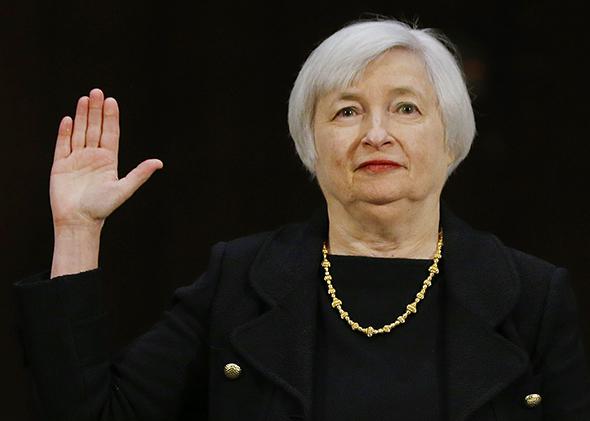Janet Yellen will make history at the end of the month when she takes office as chair of the Federal Reserve’s Board of Governors, making her the most influential female policymaker the United States has ever seen. But she also takes office under historically unique circumstances. For the first time in the Fed’s 100-year history, its chair is going to need the guts to ignore the unemployment rate, despite intense pressure to do the opposite.
If it seems odd to suggest that the best way to help the unemployed is to ignore the unemployment rate, here is some context. For decades now, the pattern of tension around the Fed has pitted what are known as “inflation hawks” against “inflation doves.” The hawks have been in ascendance for more than 30 years, save for a brief spell in the late 1990s; they believe the Fed’s overwhelming emphasis must be keeping the inflation rate low and stable. Doves, who are largely in disfavor, tend to say the Fed shouldn’t worry about overshooting its inflation target a bit if that’s what’s needed to avoid mass unemployment. Somewhat perversely, Ben Bernanke has acquired a reputation as a dove, even though on his watch inflation was the lowest it’s ever been in the postwar era, and unemployment the highest it’s ever been.
The key thing for now, however, is that the unemployment rate has ceased to be a reliable indicator of the state of the economy. Spending too much time thinking about the unemployment rate may cause you to develop an excessively optimistic view of the labor market, and an excessively pessimistic view of the economy’s capacity for growth. The key test for the Fed in 2014 will be its willingness to look past the unemployment rate at broader measures of the economy’s health.
Here’s one reason why: In the 30-month span from April 2009 to September 2011, the unemployment rate was consistently more than 9 percent. Since then, it’s fallen rather steadily. In December 2012, the jobless rate was 7.9 percent. By last month it was down to 6.7 percent. That’s tremendous progress, and it portrays an economy that may soon no longer be in need of unusual monetary measures like quantitative easing and near-zero short-term interest rates.
Unfortunately, though, the unemployment rate is a ratio. It’s the number of people out of work divided by the number of people who are looking for work. And the bulk of the action seems to be happening in the denominator. In other words, rather than finding jobs, more and more unemployed people are giving up entirely. Due to employers’ tendencies toward discrimination against the long-term unemployed, giving up isn’t an entirely irrational choice. What’s more, with congressional Republicans blocking an extension of unemployment insurance benefits, the pace of dropping out is likely to accelerate sharply. To collect unemployment insurance, you need to be actively looking for work. If you’re ineligible for benefits and know employers are putting your résumé on the fast track to the garbage bin, you have every reason to give up.
Right now the labor force participation rate is just 62.8 percent, far below the 66 percent or so of a decade ago. Some of this is demographics: The population is older than it used to be, and older folks are less likely to be working. Goldman Sachs’ chief economist, Jan Hatzius, figures that population aging accounts for about one-quarter of the decline in the participation rate.
That still leaves the bulk unaccounted for. And the participation decline is a very big deal. If the people whom the Bureau of Labor Statistics classifies as “discouraged workers” all hopped back into the labor force, the jobless rate would soar to 7.7 percent. But that still doesn’t give you the full picture. Back in the late 1990s, when unemployment was low and wages were steadily rising, we had the opposite of discouraged workers; labor force participation soared and the share of the overall population with jobs reached an all-time high. Under booming economic conditions, people who otherwise might not bother looking for a job—preferring gray- or black-market employment, disability benefits, early retirement, homemaking, etc.—went out and found work. During the Bush years, we never regaining that peak, and under Obama we haven’t even come close.
Long story short, there’s almost certainly more “slack” in the labor market than the official unemployment rate suggests. We can guess at exactly how much, but there’s no real way to know for certain. Which is another reason why Yellen needs to be a hawk and look at the inflation rate. Official inflation stats are far from perfect, but they do get one thing right: As long as inflation is low and stable, we can be sure the economy isn’t out of slack, regardless of what happens with headline unemployment. Throughout 2013, the inflation rate was very low—driven down by falling domestic energy costs thanks to the oil and gas boom. And in the couple of years before that, inflation was generally below the Fed’s 2 percent target.
When inflation rises above that target and stays there for a while, that will be the sign that the economy’s out of room to run and that the workers out of the labor force are gone forever. Normally the Fed tries to avoid this kind of inflation test, instead using other statistics to tighten monetary policy before even a whiff of inflation occurs. There may be some merits to that approach in ordinary times, but today it would be a mistake. Several years of ultra-low inflation mean we can afford to overshoot on the other side. Meanwhile, the depth of the recent recession and the havoc it’s wreaked on the labor market have left the reliability of our other statistics uncertain. To help the unemployed, the Fed needs to ignore the unemployment rate and press forward with low interest rates until some real inflation materializes.
